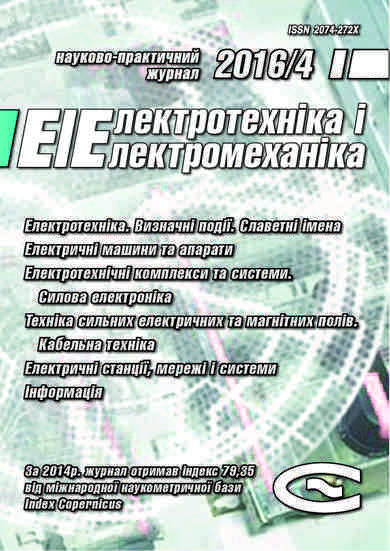ELECTROMAGNETIC VIBRATION DISTURBING FORCES AT THE ECCENTRICITY OF ROTOR OF TURBOGENERATOR
DOI:
https://doi.org/10.20998/2074-272X.2016.4.02Keywords:
turbogenerator, field mathematical model, electromagnetic vibration disturbing forces, Maxwell stress tensor, eccentricity, damage of rotor, diagnostic featureAbstract
Electromagnetic vibration disturbing forces in different variants of the rotor displacement from an axis of the stator bore is carried out. Investigation for ТG type ТGV-200-2 by finite element method in COMSOL Multiphysics is carried out. The field mathematical model of static and dynamic eccentricity is described. The amplitude vibration disturbing forces are greatest, when a static eccentricity direction coincides with an axis of the stator winding phase is shown. The diagnostic features static and dynamic eccentricities are formulated. The most value of forces in the point with minimal air gap is shown. The diagnostic features static and dynamic eccentricities and the method of diagnostic eccentricity are formulated. Diagnostic feature of static eccentricity is to change the amplitude Maxwell stress tensor is established. The dynamic eccentricity diagnostic features are appearance in the spectrum of vibration disturbing forces rotating and multiple harmonics.References
1. Vaskovskyi Yu.M., Tytko O.I., Melnyk A.M. Diagnosis of damage to the excitation winding powerful turbogenerator based on the analysis of electromagnetic forces. Works of the Institute of Electrodynamics of the National Academy of Sciences of Ukraine, 2013, no.36, pp. 40-46. (Ukr).
2. Vaskovskyi Yu.M., Tsyvinskyi S.S., Tytko O.I. Electromagnetic processes in the damper winding of hydro generator with eccentricity of air gap. Tekhnichna elektrodynamika, 2015, no.1, pp. 65-71. (Ukr).
3. Haidenko Yu.A., Vishnevskyi T.S. Electromagnetic method of diagnostic of static eccentricity of synchronous generator. Hydropower Ukraine, 2011, no.2, pp. 52-57. (Rus).
4. Levytskyi А.S., Fedorenko H.М. Characterization of air gap fault in hydrogenerators to data by sensors located on stator. Hydropower Ukraine, 2008, no.1, pp. 30-33. (Ukr).
5. Kuchynskyi K.A. Analysis of temperature field of rotor of turbogenerator capacity 300 mW at asymmetry of cooling of grooving zone. Tekhnichna elektrodynamika, 2013, no.4, pp. 59-66. (Rus).
6. Milykh V.I., Polyakova N.V Comparative analysis of the variable magnetic field on the surface of the rotor of turbogenerators with different numbers of stator teeth in the load condition. Tekhnichna elektrodynamika, 2014. no.2, pp. 29-36. (Rus).
7. Sedky M.M. Diagnosis of static, dynamic and mixed eccentricity in line start permanent magnet synchronous motor by using FEM. International journal of electrical, robotics, electronics and communications engineering, 2014, vol.8, no.1, pp. 29-34.
8. Yonggang Li, Guowei Zhou, Shuting Wan, Heming Li. Analysis of unbalanced magnetic pull on turbo-generator rotor under air-gap eccentric fault and rotor short circuit fault. International journal of advancements in computing technology, 2013, vol.5, no.4, pp. 523-530. doi: 10.4156/ijact.vol5.issue4.62.
Downloads
Published
How to Cite
Issue
Section
License
Copyright (c) 2016 Yu. M. Vaskovskyi, A. M. Melnyk, O. I. Tytko

This work is licensed under a Creative Commons Attribution-NonCommercial 4.0 International License.
Authors who publish with this journal agree to the following terms:
1. Authors retain copyright and grant the journal right of first publication with the work simultaneously licensed under a Creative Commons Attribution License that allows others to share the work with an acknowledgement of the work's authorship and initial publication in this journal.
2. Authors are able to enter into separate, additional contractual arrangements for the non-exclusive distribution of the journal's published version of the work (e.g., post it to an institutional repository or publish it in a book), with an acknowledgement of its initial publication in this journal.
3. Authors are permitted and encouraged to post their work online (e.g., in institutional repositories or on their website) prior to and during the submission process, as it can lead to productive exchanges, as well as earlier and greater citation of published work.





